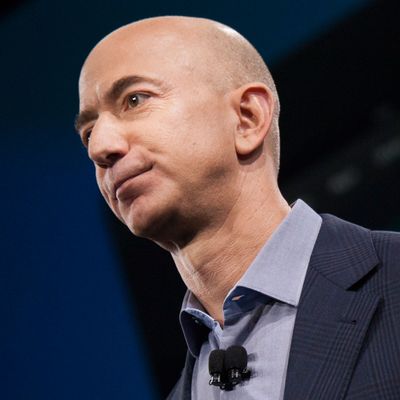
To understand Amazon and its fervent CEO Jeff Bezos, you have to understand that his company is focused relentlessly on growth — or, more specifically, on market share — above all else. He explained this philosophy further in his recent letter to shareholders.
“Jeff, what does Day 2 look like?”
That’s a question I just got at our most recent all-hands meeting. I’ve been reminding people that it’s Day 1 for a couple of decades. I work in an Amazon building named Day 1, and when I moved buildings, I took the name with me. I spend time thinking about this topic.
“Day 2 is stasis. Followed by irrelevance. Followed by excruciating, painful decline. Followed by death. And that is why it is always Day 1.”
In other words, for the sharp-toothed Bezos, this means Amazon has to keep moving — keep expanding its market and its customer base — or die.
This means you get the risky but ultimately market-defining decision to create its own e-reader hardware with the Kindle. And its aggressive moves into machine learning. And its creation of a whole new category of smart speakers with the Amazon Echo. And its early jump into cloud-hosting with Amazon Web Services (this investment in the infrastructure of the internet, invisible to most people who shop on Amazon’s website, has made the company profitable for one of the few times in the company’s history). It also means you get experiments that don’t pan out — the Amazon Fire phone, for example, or its attempt at a travel site, Destinations.
It remains to be seen which category Amazon’s recent turn to building brick-and-mortar stores, including seven (and counting) bookstores and one Amazon grocery store in Seattle, will ultimately fall under. But its acquisition of Whole Foods, which the company announced this morning, represents a vast expansion in its ambitions, and the clearest sign yet that the company that’s done more than anyone else to kill physical retail in the last decades wants to also be a physical retailer.
Sure, that $13.7 billion price tag makes Whole Foods the most expensive acquisition Amazon has ever made, by far. (The only other billion-dollar acquisition on its ledger is the online shoe store Zappos, for $1.3 billion.) But Amazon also swooped in at a time when Whole Foods (and its CEO) was publicly feuding with activist investors, who were frustrated by the high-end grocery chain’s anemic stock price, offering to buy the whole chain at $42 a share — 27 percent more than its stock was worth at the end of the trading day on Thursday.
Both sides get something out of the deal. Whole Foods is now under the umbrella of one of the world’s largest and most impressive logistics companies. While the grocery chain has (slowly) caught up to competitors when it comes to internet ordering (it outsources much of it to the shopping service Instacart), it’s lagged in managing its labor force efficiently, and lacks the size or negotiating power to demand the best deals from suppliers. As an Amazon subsidiary, it won’t have those problems.
Amazon, meanwhile, has been chasing the grocery market for over a decade now — it debuted its first grocery-delivery service with a test market in Mercer Island, Washington, in 2007. (The reason it wants in on the grocery business is pretty straightforward: Americans spend, on average, about 9 to 12 percent of their income on food, and they do so on a consistent basis. Remember what I said about Bezos’s fanatical pursuit of growth?) But AmazonFresh, its online food-delivery service, has never really caught on. Not only does the purchase of Whole Foods bring with it a hugely experienced and successful executive team, it also brings with it something Amazon needs to break into the business: 431 Whole Foods stores across the U.S., Canada, and the U.K.
“After a lot of study and experimentation with food, Amazon understood something about consumer behavior,” says Brad Stone, author of The Everything Store: Jeff Bezos and the Age of Amazon. “[Consumers] want to be in physical locations and they want to look at the perishables and whatnot. It’s also more efficient from a supply chain perspective to go in and offer and opportunity to pick up the food on the way home.”
Amazon, then, can use Whole Foods to solve the whole “look at perishables” problem it has, simply by continuing to run the stores as successful groceries. But it can also treat them as, essentially, supply depots. Right now, Uber-for-groceries companies like Instacart only serve the country’s densest metropolitan areas. Amazon — with its formidable logistical skills, immense economies of scale, and now its 400 stores across the country — can bring grocery delivery to places that haven’t previously had it.
There’s also the fact that Whole Foods, unlike many other grocery stores, is seen as a pleasant place to hang out. Many locations have food stands and tables set up for shoppers to sit down and eat. It’s not hard to imagine Amazon using some part of this space to set up, say, a program that offers discounts at Whole Foods for Amazon Prime members. On the flip side, it’s easy to see how you could use an Amazon Echo to build out a grocery list for pickup at your nearest Whole Foods.
So why, ultimately, did Amazon buy Whole Foods? Because — likely thanks to the unexpected windfall of profits from Amazon Web Services — Jeff Bezos suddenly found himself with enough cash to do so, and saw the chance to rapidly expand into a coveted category in a way that would have taken Amazon years to do on its own. To see the opportunity and not seize it would have been stasis — which, for Bezos and Amazon, means death.





























